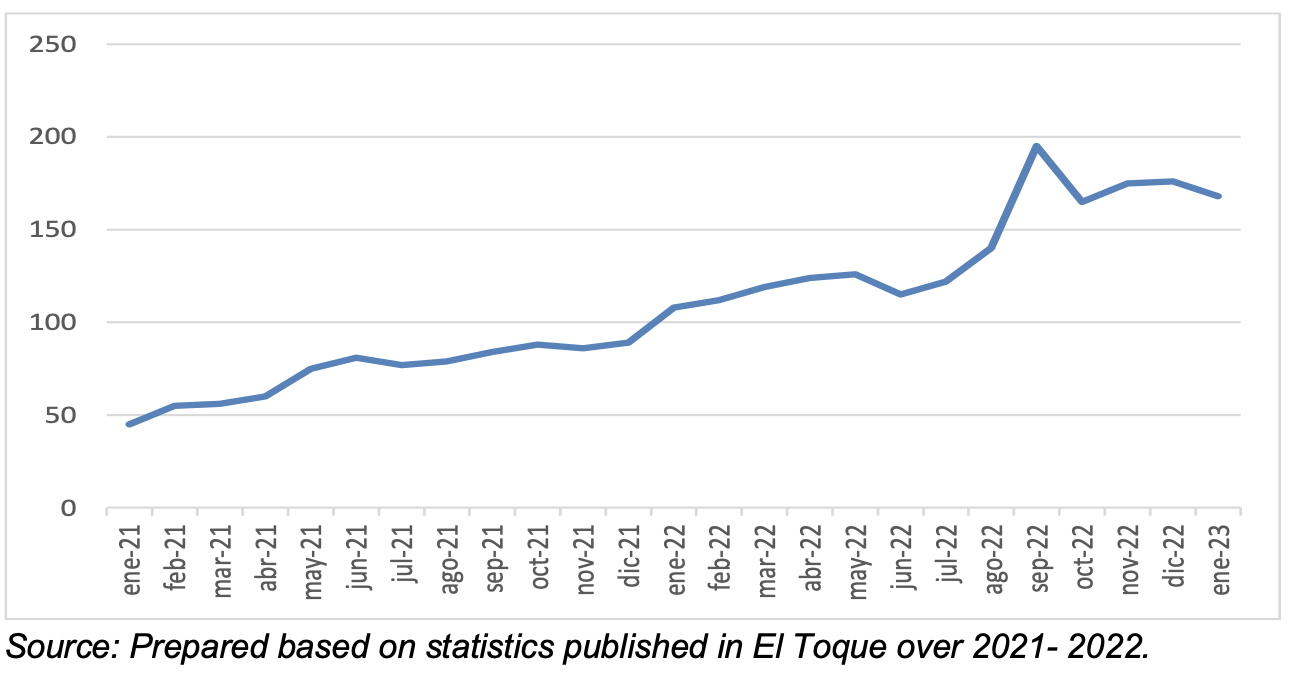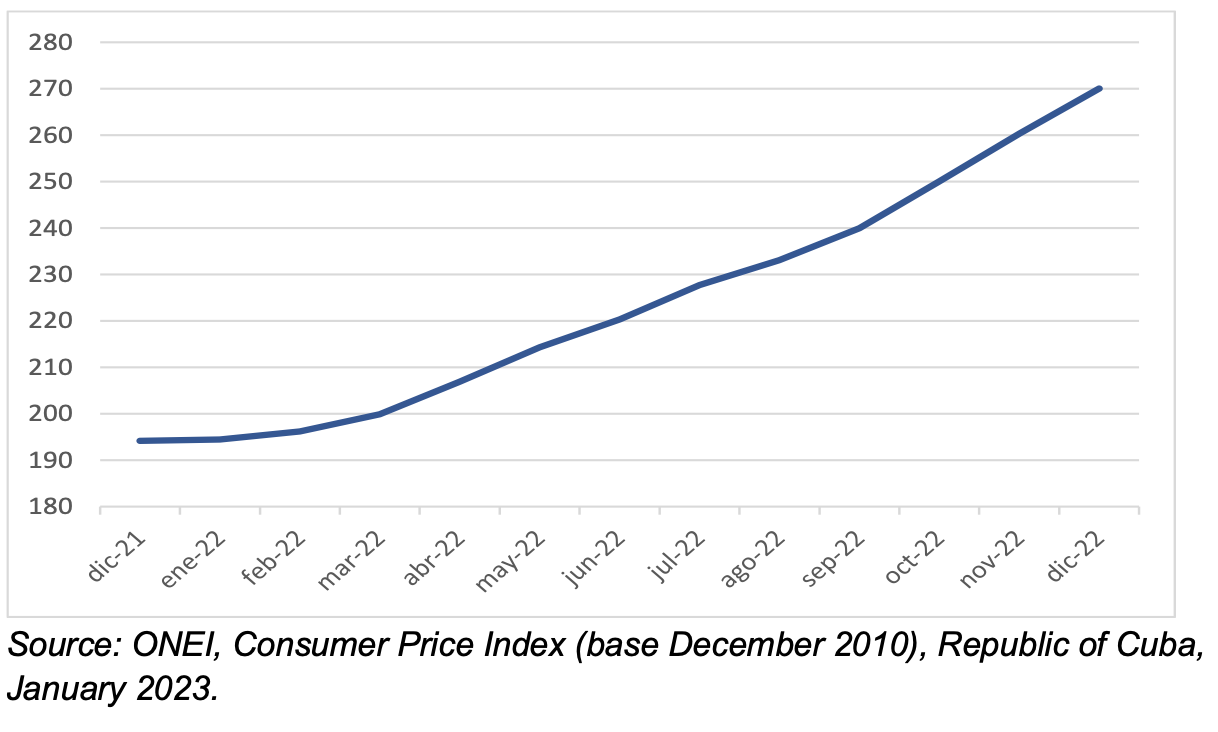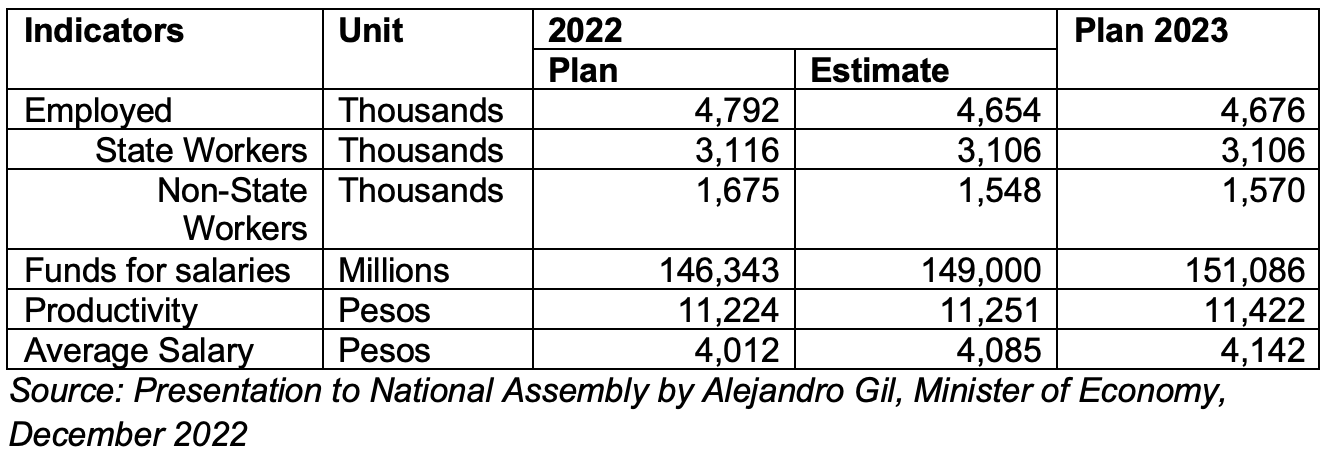Calculating the Cost of Living in Cuba
Omar Everleny Pérez Villanueva
Cuba needs a truly comprehensive economic reform that spurs the production of goods and services, as the average Cuban struggles to make ends meet.
Cuba’s unique characteristics, including its multiple markets and wide variety in the prices for the same goods, as well as its income inequality, make determining the “cost of living” a fairly complex exercise. Nonetheless, to understand what ordinary Cubans must spend to eat, clothe themselves, and cover transport to and from work, the following analysis provides approximate numbers for items generally included in the calculations of the “cost of living” worldwide.
The Concept of “Cost of Living”
Although there are myriad reasonable calculations for “cost of living”, it is broadly understood as “...the calculation or estimate of goods and services that households need to consume to achieve a certain degree of satisfaction or reach a certain standard of living” [i].
As it represents a theoretical value - the cost of goods and services that households consume to obtain a certain level of satisfaction, which is a subjective concept - it is difficult to calculate. The basic daily expenses that go into determining “cost of living” include shelter, food, clothing, taxes and health care.
Family size is also a factor in considering “cost of living”. A family of two, in which both adults work, has different needs than a family of four where only one adult works.
Minimum Remuneration and Currency Exchange Rates
In order to pay for expenses included in “cost of living”, people must be minimally remunerated, through a legally established minimum wage or minimum salary.
The type of employer affects the amount of remuneration received. It is not the same to work as a salaried employee working for a government ministry in Cuba, as it is to be an employee of a state enterprise or of a business in the private sector. In Cuba, salaries for employees of equivalent skill levels in each of these sectors will differ. After tax remuneration is generally higher in the private sector, but taxes on income from private sector activities are high.
In real terms, the minimum wage is affected by the currency exchange rate, and wages lose purchasing power during currency devaluations and inflation. State regulated increases in the minimum wage are often intended to restore the same purchasing power that existed before a devaluation or an inflationary period.
Currency exchange rates in Cuba have been increasing steadily. Since there are both official exchange rate and informal exchange markets for the various for the various currencies, as well as currency shortages when the state cannot offer necessary supplies of a particular currency in a timely manner, Cubans must access the informal currency exchange market.
Figure 1: Average Informal Rate of the Dollar against the Cuban Peso

Cuban Variations and Characteristics
One of the main causes of the high cost of living in Cuba is runaway inflation, which is present throughout the national economy.
According to the Consumer Price Index (the “Index”) of the Cuban Office of Statistics and Information (ONEI) for January 2023, in December 2022 inflation was at 270% in relation to the base calculation (2010). The methodological notes for the Index state that the national average is obtained by collecting on a monthly basis approximately 33,596 prices from 8,607 establishments located in 18 municipalities, including four municipalities in Havana province (Playa, Plaza de la Revolución, Centro Habana, and Habana Vieja), as well as the urban areas of the main municipalities of 14 other provinces. This means that this Index is only representative of prices at the country-level, not at regional or municipal levels.
Cuba calculates a basic basket of goods and services that has 298 items, which represent more than 90% of household spending and, the basic food basket is a subset of that.
Figure 2: Monthly Consumer Price Index

Let us consider the following specifics about income in Cuba:
- The minimum wage is set at 2,100 CUP (Cuban Pesos) per month.
- The average salary in Cuba is around 4,000 CUP per month (see Table 1 below).
- The average salary of health and professionals with higher education is around 6,000 CUP per month.
- The average retirement pension does not exceed 1,528 CUP per month.
The following table, derived from a presentation by Cuban Minister of Economy Alejandro Gil at the December 2022 National Assembly, provides some proposed salaries and shows how far they fall short from covering the “cost of living". The presentation calculated the "cost of living" in setting the salaries using the state established exchange rate, which varied significantly from the informal market rate. Since then, currency fluctuations in the informal market have caused the CUP to fall even more in the ensuing months.
Table 1. Employment and Wages

While there is a significant minority of workers who receive higher wages and therefore have more resources to cover their expenses, it is a minority. Moreover, another significant group of people receive remittances or other resources in convertible currency from family and friends abroad. At the existing official exchange rate of foreign currencies to Cuban pesos, wages in CUP would be higher than they actually are in the informal market, which many Cubans use to change foreign currency.
Most Cubans do not pay rent on their homes, but there are many young families that have decided to live on their own and have rented homes. Those who migrate within Cuba for work or other reasons may also rent. The minimum monthly rent in Havana is 17,000 CUP. There are peripheral municipalities where rents are lower, some closer to 10,200 CUP, but overall it is difficult or almost impossible for salaried workers to afford rent anywhere in Cuba.
Simple calculations provided in tables below, based on real prices at the beginning of 2023, show that about 32,000 CUP per month are needed per person to cover basic expenses. The amounts shown in the tables below are minimums, but they provide a sense of the living expenses of most Cubans.
Cost of Living Expenses in Cuba
Food
A central element of the Cuban “cost of living” is the cost of the basic food basket, which is a subset of the basket of goods and services described above. This is the government established set of foods expressed in quantities needed to satisfy the caloric needs of an average household [ii]. It represents a state determined dietary minimum based on the consumption pattern of a group of reference households (but not necessarily a nutrient-rich diet). Food itself is the most important component of the basic food basket, but other items are included as well, such as fuel for cooking.
The following categories are often included in a country’s basic food basket:
- Dairy
- Meats (chicken, pork, beef)
- Eggs
- Beans and lentils
- Cereals (corn, rice, bread, pasta)
- Sugars
- Fats (vegetable oil, lard)
- Vegetables
- Fruits
- Other (coffee, salt)
Below is a list of the products necessary for the subsistence of one person. The products identified under the category “Norm” are those products the quantities and prices of which are guaranteed by the state. The other products are available in either the informal markets or in hard currency markets. Table 2 lists the maximum prices in CUPs at which the products from the basic food basket are sold in the markets, as published by ONEI for the province of Havana. The prices in Havana are similar to prices in other provinces.
Table 2. Basic Food Basket

Table 2 above shows that 13,561 CUP are needed monthly to purchase even this small selection of products in modest quantities for one person.
Transportation
For purposes of this analysis and included in Table 5 below, we focus on public transportation—that is, transport by bus or by state vehicles that carry about a dozen people, called gacelas. Private transportation in collective use cars, which travel within specific routes in Havana and throughout the country, is not included.
As an example, a taxi from the Marianao municipality to the Plaza de la Revolución municipality costs 100 CUP. If the taxi is private (does not follow a fixed route on principal arteries), the minimum cost for that trajectory is 500 CUP.
So, an individual who takes the public bus 15 times a month would only pay 30 pesos for the bus transportation. But if we add two rides on a gacela, in just two daily trips the cost jumps to more than 300 CUP. And, if the individual were to take just one round-trip taxi ride per month, that is an additional cost of 1,000 CUP. Since most Cubans cannot rely merely on the spotty bus service for transportation, a reasonable calculation is that the minimum total monthly cost for transportation would be 1,330 CUP.
Clothing
As shown in Table 3 below, just one outfit costs about 9,700 CUP, without including underwear. This estimate also does not include clothing used for special occasions. Clearly these clothing items do not need to be purchased every month, but if there are growing children or teenagers in the household, clothing and footwear need to be purchased more frequently.
Table 3. Clothing & Footwear

Communications
Modern life and economic development require use of the Internet and, therefore, a smartphone to access it. Smartphones in Cuba cost between 17,000–51,000 CUP. But for our purposes we will only include in Table 5 below the minimum monthly cost of Internet access through data packages, which is around 1,200 CUP.
Personal Care
Table 4 below lists the most basic personal care items for a male individual. Absent are the costs of female personal care, which could include cosmetic items such as hair coloring and styling, manicures, makeup, etc. Those costs are very high because the supply inputs are costly and their availability fluctuates.
Table 4. Personal Hygiene

Also not included in this analysis are medicines. Due to their scarcity in Cuban medical establishments and pharmacies, most are available only in the informal market and their prices are sky-high.
Entertainment
In this analysis of “cost of living” we exclude a vital element necessary for personal satisfaction: entertainment and recreation: walks in nice surroundings, beach trips and meals in restaurants [iii] , and celebration of birthdays, anniversaries, weddings, and other important life events. Some of these can be very expensive, as, for example, the price of a small birthday cake is currently around 4,000 CUP.
In summary, Table 5 below adds up the essential expenses identified in the “cost of living” analysis: the cost of the basic food basket, transportation, clothing, personal care, and communications. Arguably, this calculation may be too low, since it does not include other necessary expenses, such as the cost of home maintenance materials, household appliances, and electricity consumption. (Running an air conditioner for eight hours a day during the long Cuban summers costs about 1,500 CUP per month).
In short, to feel minimally “normal,” a Cuban would need more than 32 000 CUP per month just to pay for the selection of goods and services in the table below.
Table 5. Cost of Living Expenses in Cuba

Conclusions
Given its economic and political system, certain goods and services are free in Cuba, such as health care, education, certain culture activities, sports, etc., but the tense economic situation, great structural economic imbalances of its system, and the embargo imposed by the United States have significantly affected the quality and availability of those goods and services. For example, certain material needs such as medical or school supplies need to be obtained by the patients and students, respectively.
Despite the direct and indirect government subsidies, the “cost of living” in Cuba is completely disproportionate to workers’ earned income. As a result, Cuban families face a high monetary income deficit and the average Cuban struggles to make ends meet.
Everyone asks this question: How can people live on so little income given such a high cost of living? There are multiple practices used by Cubans to survive:
- Some reduce their consumption of necessary goods and their quality of life decreases;
- Some receive financial assistance from family and friends abroad via remittances;
- Some engage in the informal market, both buying and selling goods and services;
- Some sell off family heirlooms; and
- Unfortunately, others engage in corruption or theft.
The Cuban government’s current macroeconomic stabilization plan will have among its priorities to increase the population’s purchasing power and will conclude that the main driver of high prices are the low levels of productivity in our country. It is not enough to produce a plan and identify the problem, but the government should develop and disseminate an action plan detailing how it will address the problem. Simply put, the domestic supply of goods and services has not met the existing demand for a long time —all of the economic measures taken by the government to date to foment a supply that meets demand have been unsuccessful.
A true comprehensive economic reform is needed, one that is capable producing an adequate supply of goods and services to the population. Anything short will only provide short-term relief.
[1] https://muyfinanciero.com/conceptos/costo-de-vida/
[2] www.incap.int/sisvan/index.php/es/areas-tematicas/herramientas-operacionales-de-apoyo/canasta-basica
[3] Generally, the prices of alcoholic beverages in Cuba are very high—a beer ranges from 250–500 CUP per unit and a bottle of soda exceeds 3,000 CUP.

